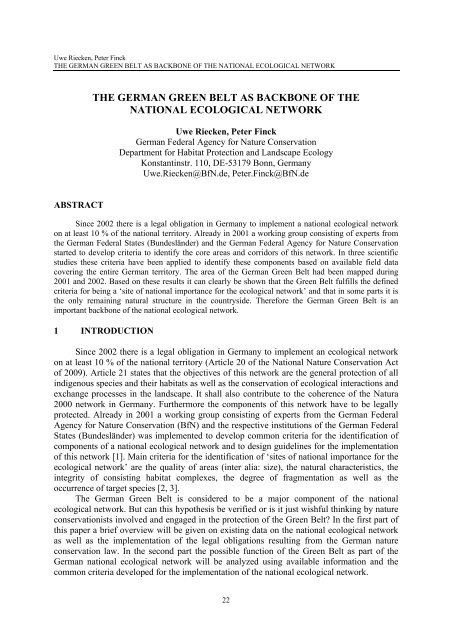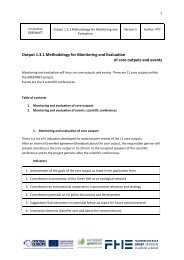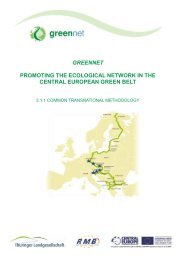The Green Belt as a European Ecological Network strengths and gaps
The Green Belt as a European Ecological Network strengths and gaps
The Green Belt as a European Ecological Network strengths and gaps
You also want an ePaper? Increase the reach of your titles
YUMPU automatically turns print PDFs into web optimized ePapers that Google loves.
Uwe Riecken, Peter Finck<br />
THE GERMAN GREEN BELT AS BACKBONE OF THE NATIONAL ECOLOGICAL NETWORK<br />
THE GERMAN GREEN BELT AS BACKBONE OF THE<br />
NATIONAL ECOLOGICAL NETWORK<br />
Uwe Riecken, Peter Finck<br />
German Federal Agency for Nature Conservation<br />
Department for Habitat Protection <strong>and</strong> L<strong>and</strong>scape Ecology<br />
Konstantinstr. 110, DE-53179 Bonn, Germany<br />
Uwe.Riecken@BfN.de, Peter.Finck@BfN.de<br />
ABSTRACT<br />
Since 2002 there is a legal obligation in Germany to implement a national ecological network<br />
on at le<strong>as</strong>t 10 % of the national territory. Already in 2001 a working group consisting of experts from<br />
the German Federal States (Bundesländer) <strong>and</strong> the German Federal Agency for Nature Conservation<br />
started to develop criteria to identify the core are<strong>as</strong> <strong>and</strong> corridors of this network. In three scientific<br />
studies these criteria have been applied to identify these components b<strong>as</strong>ed on available field data<br />
covering the entire German territory. <strong>The</strong> area of the German <strong>Green</strong> <strong>Belt</strong> had been mapped during<br />
2001 <strong>and</strong> 2002. B<strong>as</strong>ed on these results it can clearly be shown that the <strong>Green</strong> <strong>Belt</strong> fulfills the defined<br />
criteria for being a ‘site of national importance for the ecological network’ <strong>and</strong> that in some parts it is<br />
the only remaining natural structure in the countryside. <strong>The</strong>refore the German <strong>Green</strong> <strong>Belt</strong> is an<br />
important backbone of the national ecological network.<br />
1 INTRODUCTION<br />
Since 2002 there is a legal obligation in Germany to implement an ecological network<br />
on at le<strong>as</strong>t 10 % of the national territory (Article 20 of the National Nature Conservation Act<br />
of 2009). Article 21 states that the objectives of this network are the general protection of all<br />
indigenous species <strong>and</strong> their habitats <strong>as</strong> well <strong>as</strong> the conservation of ecological interactions <strong>and</strong><br />
exchange processes in the l<strong>and</strong>scape. It shall also contribute to the coherence of the Natura<br />
2000 network in Germany. Furthermore the components of this network have to be legally<br />
protected. Already in 2001 a working group consisting of experts from the German Federal<br />
Agency for Nature Conservation (BfN) <strong>and</strong> the respective institutions of the German Federal<br />
States (Bundesländer) w<strong>as</strong> implemented to develop common criteria for the identification of<br />
components of a national ecological network <strong>and</strong> to design guidelines for the implementation<br />
of this network [1]. Main criteria for the identification of ‘sites of national importance for the<br />
ecological network’ are the quality of are<strong>as</strong> (inter alia: size), the natural characteristics, the<br />
integrity of consisting habitat complexes, the degree of fragmentation <strong>as</strong> well <strong>as</strong> the<br />
occurrence of target species [2, 3].<br />
<strong>The</strong> German <strong>Green</strong> <strong>Belt</strong> is considered to be a major component of the national<br />
ecological network. But can this hypothesis be verified or is it just wishful thinking by nature<br />
conservationists involved <strong>and</strong> engaged in the protection of the <strong>Green</strong> <strong>Belt</strong>? In the first part of<br />
this paper a brief overview will be given on existing data on the national ecological network<br />
<strong>as</strong> well <strong>as</strong> the implementation of the legal obligations resulting from the German nature<br />
conservation law. In the second part the possible function of the <strong>Green</strong> <strong>Belt</strong> <strong>as</strong> part of the<br />
German national ecological network will be analyzed using available information <strong>and</strong> the<br />
common criteria developed for the implementation of the national ecological network.<br />
22




